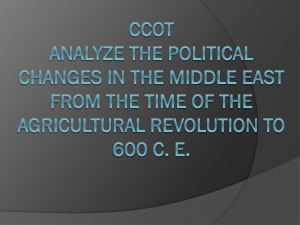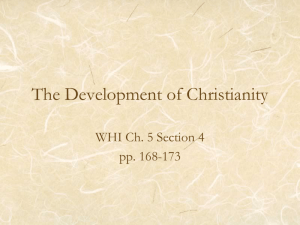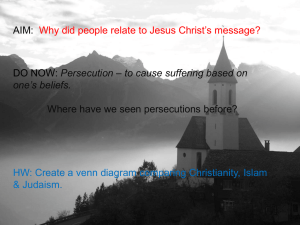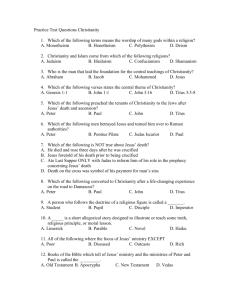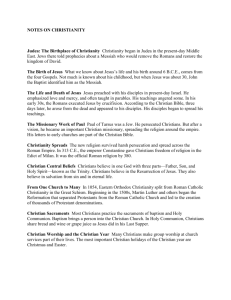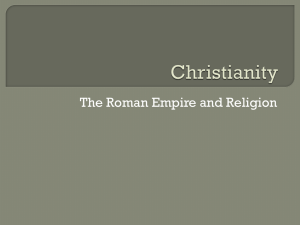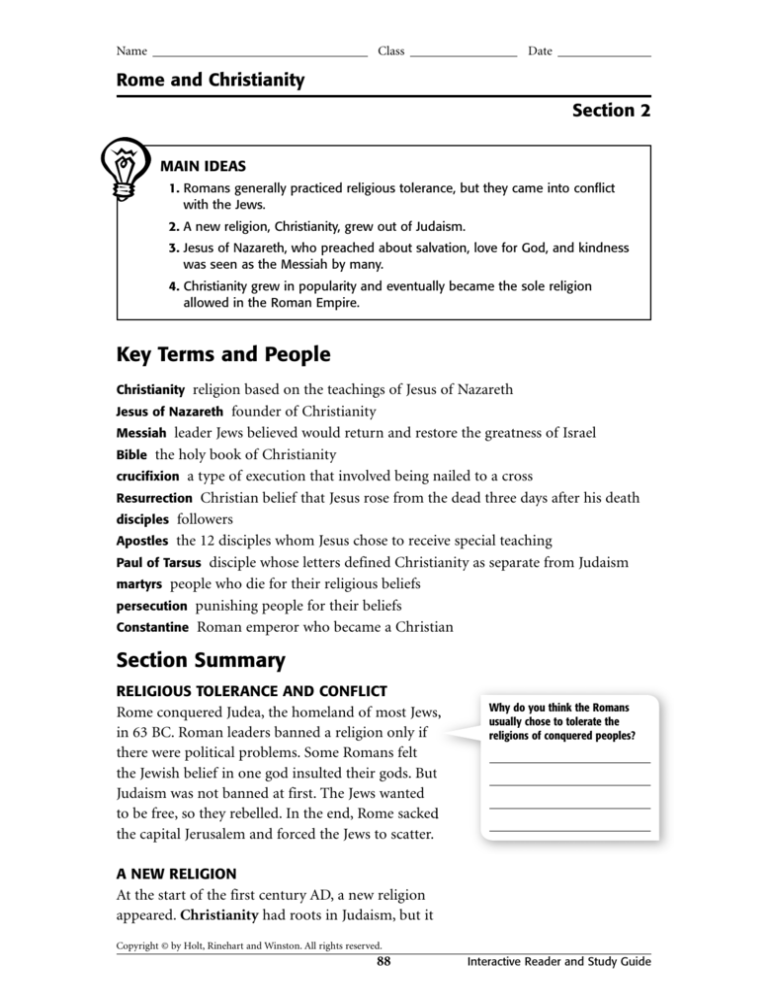
Name
Class
Date
Rome and Christianity
Section 2
MAIN IDEAS
1. Romans generally practiced religious tolerance, but they came into conflict
with the Jews.
2. A new religion, Christianity, grew out of Judaism.
3. Jesus of Nazareth, who preached about salvation, love for God, and kindness
was seen as the Messiah by many.
4. Christianity grew in popularity and eventually became the sole religion
allowed in the Roman Empire.
Key Terms and People
religion based on the teachings of Jesus of Nazareth
Jesus of Nazareth founder of Christianity
Messiah leader Jews believed would return and restore the greatness of Israel
Bible the holy book of Christianity
crucifixion a type of execution that involved being nailed to a cross
Resurrection Christian belief that Jesus rose from the dead three days after his death
disciples followers
Apostles the 12 disciples whom Jesus chose to receive special teaching
Paul of Tarsus disciple whose letters defined Christianity as separate from Judaism
martyrs people who die for their religious beliefs
persecution punishing people for their beliefs
Constantine Roman emperor who became a Christian
Christianity
Section Summary
RELIGIOUS TOLERANCE AND CONFLICT
Rome conquered Judea, the homeland of most Jews,
in 63 BC. Roman leaders banned a religion only if
there were political problems. Some Romans felt
the Jewish belief in one god insulted their gods. But
Judaism was not banned at first. The Jews wanted
to be free, so they rebelled. In the end, Rome sacked
the capital Jerusalem and forced the Jews to scatter.
Why do you think the Romans
usually chose to tolerate the
religions of conquered peoples?
A NEW RELIGION
At the start of the first century AD, a new religion
appeared. Christianity had roots in Judaism, but it
Copyright © by Holt, Rinehart and Winston. All rights reserved.
88
Interactive Reader and Study Guide
Name
Class
Date
Section 2, continued
was based on the teachings of Jesus of Nazareth.
At this time there were several Jewish groups. The
largest group followed Moses’s laws very strictly
to ensure that a savior would appear. This savior
was called the Messiah (muh-SY-uh), which means
“God’s chosen one.” When Judea had fallen, many
Jews felt the Messiah would come soon.
Jesus of Nazareth was born at the end of the first
century BC. Much of what we know about Jesus is
from the Bible, the holy book of Christianity. Jesus
was born in Bethlehem (BETH-li-hem) to a woman
named Mary. Christians believe that God was Jesus’s
father. When Jesus was about 30, he began to travel
and teach. Roman leaders thought his teachings
challenged their authority. Jesus was arrested and
executed by crucifixion. Christians believe Jesus
rose from the dead. This is called the Resurrection.
Many of Jesus’s disciples claimed to see him again.
Jesus taught that people should love God and
each other. Jesus also taught about salvation. Jesus
chose 12 of his disciples, the Apostles, to spread his
teachings. However another man, Paul of Tarses,
was most important in spreading Christianity. Paul
traveled and wrote letters explaining Christianity.
He helped Christianity break away from Judaism.
THE GROWTH OF CHRISTIANITY
As Christianity became more popular, Roman
leaders began to worry. Christians began preaching
to Jews and non-Jews. Some local leaders arrested
and killed Christians. These martyrs died for their
religious beliefs. Some Roman emperors outlawed
Christianity and persecuted Christians.
In the early 300s, emperor Constantine became a
Christian and removed the bans on Christians. Later
Christianity became the official religion of Rome.
Why do you think the Messiah
was so important for the Jews
who were living in Judea under
Roman rule?
Do you think modern leaders who
say they are Christians act with
Jesus’s teachings in mind? Why or
why not? Provide examples to
support your opinion.
Why do you think the early
Christians were slow to offer their
message to non-Jews?
CHALLENGE ACTIVITY
Critical Thinking: Drawing Inferences How did Emperor Hadrian deal
with religious rebels? Would you do the same? Explain why or why not.
Copyright © by Holt, Rinehart and Winston. All rights reserved.
89
Interactive Reader and Study Guide





